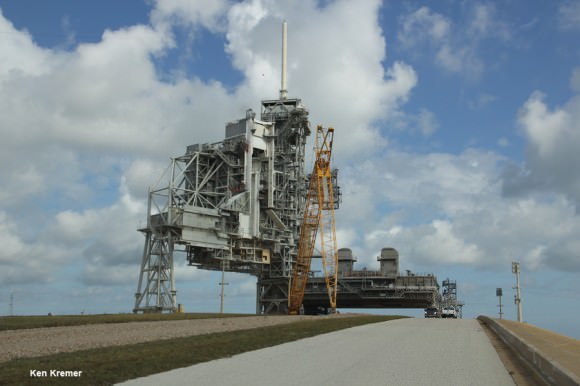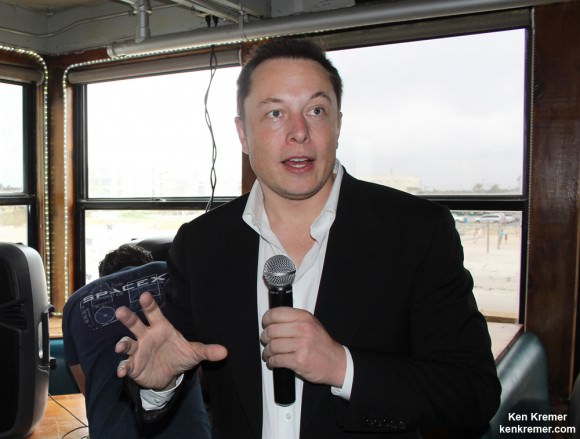SpaceX released a cool new animation today, Jan. 27, showing an updated look at their Falcon Heavy rocket and plans for booster recovery. See below.
The Falcon Heavy is the brainchild of billionaire entrepreneur Elon Musk, SpaceX CEO and founder, and illustrates his moving forward with the firm’s next giant leap in spaceflight.
The rocket is designed to lift over 53 tons (117,00 pounds) to orbit and could one day launch astronauts to the Moon and Mars.
The commercial Falcon Heavy rocket has been under development by SpaceX for several years and the initial launch is now planned for later this year from Launch Complex 39A at the Kennedy Space Center (KSC) in Florida.
The new rocket is comprised of three Falcon 9 cores.
The Falcon Heavy will be the most powerful rocket developed since NASA’s Saturn V rocket that hurled NASA’s Apollo astronauts to the Moon in the 1960s and 1970s – including the first manned landing on the Lunar surface by Neil Armstrong and Buzz Aldrin in July 1969.
Here is the updated animation of the SpaceX Falcon Heavy flight and booster recovery:
Video Caption: Animation of SpaceX Falcon Heavy launch and booster recovery. Credit: SpaceX
The video shows the launch of the triple barreled Falcon Heavy from Launch Complex 39A at NASA’s Kennedy Space Center in Florida. Then it transitions to the recovery of all three boosters by a guided descent back to a soft touchdown on land in the Cape Canaveral/Kennedy Space Center area.
SpaceX, headquartered in Hawthorne, CA, signed a long term lease with NASA in April 2014 to operate seaside pad 39A as a commercial launch facility for launching the Falcon Heavy as well as the manned Dragon V2 atop SpaceX’s man-rated Falcon 9 booster.
Launch Complex 39A has sat dormant for over three years since the blastoff of the final shuttle mission STS-135 in July 2011 on a mission to the International Space Station (ISS).

SpaceX is now renovating and modifying the pad as well as the Fixed and Mobile Service Structures, RSS and FSS. They will maintain and operate Pad 39A at their own expense, with no US federal funding from NASA.
When it does launch, the liquid fueled Falcon Heavy will become the most powerful rocket in the world according to SpaceX, generating nearly four million pounds of liftoff thrust from 27 Merlin 1D engines. It will then significantly exceeding the power of the Delta IV Heavy manufactured by competitor United Launch Alliance (ULA), which most recently was used to successfully launch and recover NASA’s Orion crew capsule on its maiden unmanned flight in Dec. 2014

NASA’s 135th and final shuttle mission takes flight on July 8, 2011, at 11:29 a.m. from the Kennedy Space Center in Florida bound for the ISS and the high frontier with Chris Ferguson as Space Shuttle Commander. Credit: Ken Kremer/kenkremer.com
SpaceX recently completed a largely successful and history making first attempt to recover a Falcon 9 booster on an ocean-going “drone ship.” The rocket nearly made a pinpoint landing on the ship but was destroyed in the final moments when control was lost due to a loss of hydraulic fluid.
Read my story with a SpaceX video – here – that vividly illustrates what SpaceX is attempting to accomplish by recovering and ultimately reusing the boosters in order to dramatically cut the cost of access to space.
Stay tuned here for Ken’s continuing Earth and planetary science and human spaceflight news.



I like the music. Was interesting watching the side rockets touch down at the same time. I can’t imagine they would not be staged a minute or five apart. Like planes are staged so the air has a chance to smooth out. However SpaceX shows them touching down together.
Ioconnor too! for reals
That’s potentially a lot of fuel in a rocket being aimed at Florida. I’d like to know how that will get past all the safety considerations, since (as far as I know) returning objects like the space shuttle have minimal fuel and just glide down.
Well that’s why they’re testing it using a barge at sea, only once proven will they try and bring it back to land. Also pretty sure there’s only dregs left in them by the time they land, they’re so light by that stage that they only need the one engine to touch down. Still, I wouldn’t want it falling on my house…
Am sure that MOST of the fuel will be used by the time the boosters return, leaving just enough for landing. And I’ll wager that SpaceX will put auto destruct explosives on the boosters for worst case scenarios?
The discussions between Space-X engineers concerning how to fly back the first stage would be interesting to review. The choice between returning the stage to land like an airplane on a runway verses what they are doing now must have been something to see. Others over the years, one being Wernher Von Braun, also looked at the issue of stage return. Braun was leaning towards a runway landing.
haha! The D chord outro at the end of the song at the same time the satellite is released is so anticlimactic. 😀
SpaceX, the Columbus of our age… Go!
Ditto on Tihomir’s comment! This is the first time I’ve seen confirmation that all three boosters of the Falcon Heavy will be returned to the launch site. The first two appear much easier to recover compared to the third with it’s high altitude return.
Might one assume the third booster will require more maintenance than the other two? The graphite landing legs and rocket engines experience higher re-entry temps for a longer period of time combined with hot reverse rocket exhaust an issue? I’ll note here that in earlier Grasshopper flights the legs were smoking hot after landing and there aren’t many materials that will withstand blowtorch temperatures regularly and maintain their structural integrity. Got titanium? Even better, a ‘foamed’ titanium, which is of course a zero gee foundry product. Lunar titanium?
Quite frankly, I’m a bit surprised they aren’t using a transonic drogue chute/drag anchor(s) after apogee..